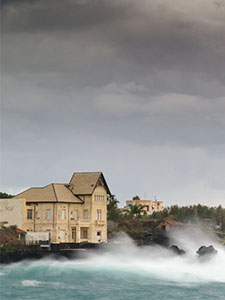POST TAGS
Homeowners InsuranceBlog posted On May 12, 2021

After years of saving and dreaming, you’re finally ready to invest in that house by the beach. But before you do, it’s important to make sure that your money (and home) will be protected. While homeowners insurance might not stop bad things from happening to your home, it can help compensate you in the case of a bad event.
How much is homeowners insurance for a vacation home?
Homeowners insurance premiums typically range from $500 to $3,500 but can be more or less depending on your dwelling coverage and home location. According to Bankrate, the national average for homeowners insurance is around $1,300 per year (for a $250,000 dwelling coverage). Homeowners insurance for properties in a seasonal town or vacation area might cost more. “If we’re looking at two identical risks, you could probably say a second home may be 20% to 25% higher [to insure],” says Nancy Albanese, vice president of personal insurance at Bryn Mawr Trust.
Why is vacation home insurance more expensive?
You might think that homeowners insurance on a second home should be less expensive because you spend less time there. However, home vacancy is one of the factors that makes second homes riskier in the eyes of insurers. If you’re gone for several weeks (or months), an issue like a burst pipe or flood might go unnoticed for a longer time – leading to more damage. There’s also an increased risk of burglary with homes that are uninhabited for long durations.
The location of vacation homes may also make them more expensive to insure. When deciding on insurance premiums, the insurance company might assess how long it could take emergency services to reach the home in case of an emergency. If you have a mountain home or a property in another difficult-to-reach area, it could take longer for a fire department to reach the home – increasing the amount of possible destruction in the event of a fire or other natural disaster. “Sometimes we see homes that are in the mountains and they might be quite a distance from the nearest fire department, might not be visible to neighbors, [or] might not have a fire hydrant within a reasonable distance,” said Albanese.
Another location risk factor of vacation homes is their susceptibility to natural disasters. “Many second homes are located in areas that are considered hazardous for insurance companies,” Albanese says. Beach homes can have an increased risk of flooding while woodsy cabins might be at risk of forest fires. A vacation home in a flood zone incurs a $250 surcharge. “The premium for highly-exposed properties can be approaching $10,000 in some extreme cases,” Albanese says. “It’s very specific to the location and the characteristics of the home.”
How to keep your insurance premiums low
One tactic that could reduce your home insurance costs is visiting it more often. If you can show your insurer that you spend every other weekend at the house (as opposed to certain seasons), then you might be able to qualify for lower rates. However, this strategy isn’t an option for everyone, such as people who have vacation homes in other parts of the country.
Other options include:
By bundling your homeowners insurance with other policies like car insurance, you can get better deals from your insurer. “Many insurance companies do not want to insure a secondary home on a standalone basis, so it’s often very beneficial to bundle the second home with your other insurance policies, if possible,” Albanese says.
Raising your deductible can reduce your premiums too. If you increase your deductible from $1,000 to $2,500, then you could see your deductible drop by 10%. Reducing coverage might be a good idea too. You don’t necessarily need to copy all of the terms for your primary residence policy to your vacation home policy. Be sure to work with your insurer to see if you can reduce coverage in certain areas of your second home’s insurance.
Investing in mitigation equipment – fire alarms, security cameras – can decrease certain risks for your insurer. Make sure that these devices are linked to a central monitoring system, so that you can get notified of any incident even when you’re not in the home. The money spent on these devices could be paid off in deductible savings if your devices help prevent extensive damages.
Homeowners insurance can be costly, but it can also save you thousands down the road. If you’d like to know if your home is in a high-risk area, talk to your insurance company. If you would like help finding a homeowners insurance company, let us know. There are also several online resources such as the FEMA Flood Map Service Center.
Sources: Bankrate, Money.com,